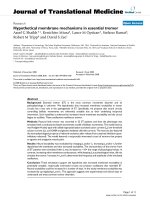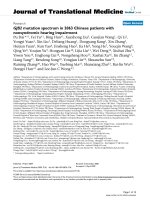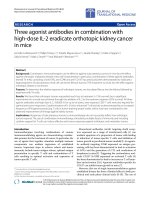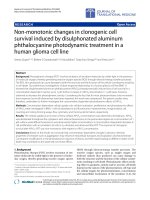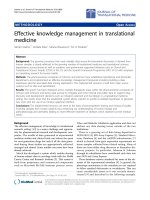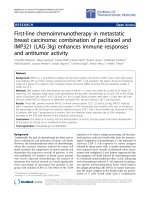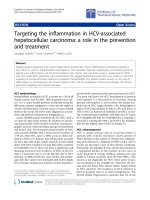Báo cáo hóa học: " Occupational injury proneness in Indian women: A survey in fish processing industries" doc
Bạn đang xem bản rút gọn của tài liệu. Xem và tải ngay bản đầy đủ của tài liệu tại đây (233.88 KB, 5 trang )
BioMed Central
Page 1 of 5
(page number not for citation purposes)
Journal of Occupational Medicine
and Toxicology
Open Access
Research
Occupational injury proneness in Indian women: A survey in fish
processing industries
Asim Saha*
1,2
, Anjali Nag
1
and Pranab Kumar Nag
1
Address:
1
National Institute of Occupational Health, Ahmedabad, India and
2
Senior Research Officer (Medical), Occupational Medicine Division,
National Institute of Occupational Health, Meghani Nagar, Ahmedabad-380 016, Gujarat, India
Email: Asim Saha* - ; Anjali Nag - ; Pranab Kumar Nag -
* Corresponding author
Abstract
A cross sectional survey was initiated to understand the frequency of occupational injury
occurrence and the associated factors in the fish processing industries of western India involving
185 randomly selected women subjects. All the subjects were interviewed with the help of an
interviewer-administered questionnaire to collect information regarding their personal,
occupational and work related morbidity details (including details of occupational injuries). Logistic
regression method was used to analyze the data in order to obtain the contribution of individual
factors on occupational injuries. This study has shown that work related morbidity like blanching
of hand (OR; 2.30, 95%CI; 1.12–4.74) and nature of job like grading (OR; 3.99, 95%CI; 1.41–11.27)
and packing (OR; 5.68, 95%CI; 1.65–19.57) had a significant impact on injury causation. This study
eventually concludes that apart from nature of job of fish processing workers occupational hazards
prevailing in the work environment contribute significantly to the occurrence of work related
injuries and prevention of such occupational hazards may help in protecting workers from
occupational injuries also.
Background
Occupational injuries represent a major problem in pub-
lic health. Severe consequences also do occur as after-
effect [1]. Social and economic loss takes place [2,3]. Every
year almost one thousand workers die and one fourth of
a million are injured in industries in India in organized
sectors only. Thousands of others are crippled due to
occupational injuries in unorganized sectors. Number of
insured persons in the pay roll of permanent disablement
benefit reached up to 113,500 with addition of about
15,000 fresh cases of disablement due to employment
injury during a single year in India only [4]. So far as the
causation of such injuries is concerned, a variety of factors
have been found to be responsible for occupational acci-
dents, either directly or indirectly. Work conditions [5],
age [6,7], safety training [8], experience [9] and weather
[10] have all been designated as responsible factors. Some
authors have also shown that the type of employment of
the worker (temporary or permanent) [11] is also an
important factor in the causation of occupational acci-
dents. In recent times, contribution of poor work environ-
mental conditions [12,13], poor perception of work
conditions [12] and presence of disease of adverse health
condition in workers [14,15] on occupational injury
occurrence has been highlighted. Nature of workplaces
being varied, determinants of occupational injury causa-
tion has also been different and identification of such
responsible factors in relation to a specific work environ-
ment has not only helped in exploring the aetiology but
also been useful in planning prevention.
Published: 12 September 2006
Journal of Occupational Medicine and Toxicology 2006, 1:23 doi:10.1186/1745-6673-1-23
Received: 23 March 2006
Accepted: 12 September 2006
This article is available from: />© 2006 Saha et al; licensee BioMed Central Ltd.
This is an Open Access article distributed under the terms of the Creative Commons Attribution License ( />),
which permits unrestricted use, distribution, and reproduction in any medium, provided the original work is properly cited.
Journal of Occupational Medicine and Toxicology 2006, 1:23 />Page 2 of 5
(page number not for citation purposes)
In fish processing industry the workers use small sharp
knife and their hands come in contact with different sharp
body parts of fishes. Use of such small hand tools and
manual work often exposes workers to frequent minor
injuries [16], which in long term may be harmful. A study
conducted in UK [17] estimated that almost one in 10
workers in such profession attend casualty in the course of
a year for a work related injury. A postulation of seven-
teen-knife laceration per 1000 per annum was also made.
In addition, low temperature of work environment and
frequent contact with ice cold chlorinated water makes
the workers suffer from many other morbidities including
frequent respiratory irritation (frequent sneezing and/or
coughing) at work, headache, blanching of hand etc.
Though respiratory [18] and musculoskeletal [19] prob-
lems of fish processing workers have been addressed
repeatedly, hardly any effort is made to explore the prob-
lem of injury occurrence in such workplaces. In this back-
drop this study was undertaken not only to understand
the frequency of injury occurrence and the associated fac-
tors but also to test the hypothesis whether sufferings of
workers (due to work or work environment) have any sig-
nificant contribution to the occurrence of occupational
injuries.
Materials and methods
This cross sectional survey was conducted in the sea fish
processing industries situated in Gujarat state of western
India. This part of India has number of such industries
that employ 20000 women workers. A peculiar feature of
these industries is that they are employing women work-
ers only for the job of fish processing (only a few male
workers are employed for supportive activities). This was
the reason of restricting this study to women workers
only. On arrival of fish, grading (including debridement)
is done initially to segregate them into different catego-
ries. Afterwards peeling is done where necessary. Some
fishes are chopped into rings (ring cutting) and some are
sent for packing per se. Finally packing is done. Peeling is
done mostly manually (needed in case of small shrimps
only) and ring cutting is a mechanized process in most of
the units. Small hand tools like knife, needle are used in
grading and packing. The whole activity is done at a low
room temperature and hardly any personal protective
equipment being used the hands of workers come in fre-
quent contact with ice and ice cold water. To calculate the
sample size for this study, prevalence of the outcome var-
iable in reference group and relative risk of the vulnerable
worker group was predicted to be 30% and 1.75% respec-
tively. Thus, the minimum sample size for 5% level of sig-
nificance and 80% power of study was calculated as 166.
We set our target as 200 persons. At first five industries
were selected randomly from a list of all the industries of
that area. Afterwards, random selection of subjects was
done from the list of workers of those five industries by
using random numbers generated from Microsoft Excel
software. Among the 200 workers, who were approached
for study, 185 subjects participated. All of them were
interviewed with the help of an interviewer-administered
questionnaire to collect information regarding their per-
sonal, occupational and work related morbidity details
(including details of occupational injuries). Necessary
approval for this study was obtained from the institu-
tional ethical committee as well as the scientific advisory
committee of National Institute of Occupational Health,
India.
Initially, a descriptive analysis was done to observe the
personal and occupational characteristics of the study
subjects as well as to understand the prevalence of differ-
ent work related morbidities including occupational inju-
ries. A worker having injury as frequently as once a month
(30 days) over the period of last one year was considered
as "frequent injury" receiver. Hand injuries being exclu-
sively common in such workplaces this questionnaire sur-
vey was restricted to information related to hand injuries
only. Moreover, injuries those compelled the workers to
be away from the work for at least one shift (loss of wages
for a day) were considered for this study. Afterwards, anal-
ysis was done with the help of SPSS Release 6.1.4 software
to obtain the contribution of different factors on occupa-
tional injury occurrence. In univariate analysis the contri-
bution of the variables like age group, job duration group,
marital status, education level, nature of job, blanching of
hand at work, recurrent musculoskeletal pain, headache
during work, recurrent sneezing/coughing (respiratory
irritation) at work on injury occurrence was examined. In
multivariate analysis, logistic regression method was used
to obtain the contribution of individual factors on occu-
pational injuries irrespective of the effect of the other fac-
tors. Variables like blanching of fingers due to cold during
work (yes, no), education level (illiterate, educated),
department/nature of job (department with lowest injury
was treated as reference and the risk of others were calcu-
lated), marital status (married, unmarried), musculoskel-
etal problem anywhere in the body (yes, no) and pain in
upper limb (yes, no) were taken as categorical variables.
Other variables like age (yrs), experience in this job (yrs)
were taken as continuous variables. While analyzing, we
used three logistic regression models. In the first, we
accommodated only three variables (age, education level,
marital status). In the second we added the morbidity var-
iables (blanching of hand, musculoskeletal pain, pain in
upper limb) also. Finally in the third we added the varia-
bles related to work (department/nature of job and expe-
rience in the job) and analyzed all variables
simultaneously in the model in order to estimate the
effect of every individual variable adjusting for the effect
of other variables.
Journal of Occupational Medicine and Toxicology 2006, 1:23 />Page 3 of 5
(page number not for citation purposes)
Results
Mean age of the study subjects was 24.4 (± 7.4) years. One
hundred & thirty two (71.4%) workers were ≤ 25 years old
and 53 (28.6) workers were more than 25 years old. Mean
job duration of the subjects was 3.8 (± 3.3) years. Almost
80% workers had job experience of ≤ 5 years. Ninety five
percent subjects were educated, while 5% were illiterate.
One hundred & nine workers (58.9%) were unmarried.
Majority of the workers (58.4%) were from grading sec-
tion while 18.4% were from packing division. About 15%
workers were engaged in peeling and ring cutting while
rest of the workers were in mixed type of job.
So far as morbidity is concerned the workers were suffer-
ing from repeated injuries (49.7%), blanching during
work (71.9%), recurrent musculoskeletal pain (61.1%)
and recurrent (sneezing/coughing) respiratory irritation
(14.6%). Almost 44% workers complained of headache
during work while body ache and upper limb pain was
reported by 4.9% and 22.2% subjects respectively (Table
1).
On univariate analysis some of the workers' characteristics
were found to have significant effect on injury causation
(Table 2). Age more than 25 years (RR; 1.56, 95%CI;
1.06–2.31), married status (RR; 1.5, 95%CI; 1.13–1.99),
higher education level (RR; 0.62, 95%CI; 0.42–0.91), job
of grading (RR; 1.96, 95%CI; 1.01–3.82) and packing
(RR; 2.61, 95%CI; 1.32–5.14) as well as blanching (RR;
1.41, 95%CI; 1.06–1.86) and recurrent musculoskeletal
pain (RR; 1.35, 95%CI; 1.02–1.79) has significant impact
on injury causation while variables like job duration,
headache, respiratory irritation did not show any signifi-
cant impact. When multivariate analysis was done (Table
3) using logistic regression model to understand the effect
of different worker characteristics on injury occurrence, it
was observed that while analyzing with the first model
(age, education level, marital status), marital status was
found to have significant contribution on occupational
injury occurrence. In the second model when morbidity
parameters were added, it was observed that marital status
lost its significance and only blanching of hand at work
Table 1: Personal and occupational characteristics of workers
Variables Percentage (N = 185)
Age group
>25 28.6
Job duration
>5 21.1
Educational status
Educated (not illiterate) 95.1
Marital status
Married 41.1
Nature of Job
Grading 58.4
Peeling & Ring cutting 14.6
Packing 18.4
Mixed activity 8.6
Work related morbidity
Frequent hand injury 49.7
Blanching of hand 71.9
Headache 43.8
Respiratory irritation (sneezing/coughing) 14.6
Body ache 4.9
Recurrent musculoskeletal pain 61.1
Recurrent upper limb pain 22.2
Table 2: Association of worker characteristics on injury occurrence (univariate analysis)
Variables Injury (%) P value RR 95% CI
Age group
>25 (compared against ≤25) 64.2 0.013 1.56 1.06–2.31
Job duration
>5 (compared against ≤5) 46.2 0.615 0.92 0.66–1.28
Education level
Educated (compared against illiterate) 48.3 0.084 0.62 0.42–0.91
Marital status
Married (compared against unmarried) 61.84 0.006 1.50 1.13–1.99
Nature of Job
Grading 50.9 0.013 1.96 1.01–3.82
Peeling & Ring cutting 25.9 1 -
Packing 67.6 2.61 1.32–5.14
Mixed activity 43.4 1.69 0.72–3.93
Blanching of hand 54.9 0.025 1.41 1.06–1.86
Headache 51.9 0.610 1.08 0.81–1.44
Recurrent respiratory irritation during work 48.1 0.859 0.96 0.65–1.43
Body ache 33.3 0.313 0.74 0.46–1.20
Recurrent musculoskeletal pain 55.8 0.040 1.35 1.02–1.79
Recurrent upper limb pain 53.7 0.568 1.11 0.77–1.60
Journal of Occupational Medicine and Toxicology 2006, 1:23 />Page 4 of 5
(page number not for citation purposes)
had significant effect. In the final/third model where all
the variables were analyzed simultaneously, it was found
that blanching of hand was the only work related morbid-
ity, which had a significant impact on injury causation
(OR; 2.30, 95%CI; 1.12–4.74). So far as the job character-
istics are concerned, the act of grading (OR; 3.99, 95%CI;
1.41–11.27) and packing (OR; 5.68, 95%CI; 1.65–19.57)
had significantly higher risk of contacting work related
injuries.
Discussion
Studies on fish processing workers have highlighted skin
rashes, asthma and allergies as common work related
symptoms [20]. Musculoskeletal problems have also been
talked about [19,21]. Study conducted in Sweden on such
workers showed that women workers are more suscepti-
ble to work related morbidities in comparison to their
male counterparts despite superficially similar work [22].
So far as workplace injuries are concerned reports are
there to show that injuries are higher in fish processing
workers than non-exposed workers and women workers
are more vulnerable than male workers (females: OR =
4.3; 95%CI = 3.0–5.9; males: OR = 1.8; 95%CI = 1.2–2.7)
[23].
Though the studies conducted in fish processing indus-
tries have already highlighted that work related injury is a
major problem area, hardly any study has explored the
determinants. This present study has made an effort to
identify the probable factors responsible for such work
injuries so that this knowledge can ultimately help in pre-
vention. On univariate analysis age group, marital status,
education level, musculoskeletal pain, blanching of hand
at work and nature of job showed significant contribu-
tion. But on multivariate analysis only blanching of hand
and nature of job was found to have significance. Marital
status showed significance in first model of multivariate
analysis, but could sustain it at later stages. A peculiar pat-
tern of such industries in India is that they almost exclu-
sively employ women and most of these women (poor,
less educated and migrated from different backward areas
of the country) leave this job within 5 years of joining this
job by the age of 25–26 yrs (mostly because of getting
married). Those who stay here beyond 25–26 yrs are usu-
ally under mental tension either due to the social stigma
of not getting married in time (in case of unmarried
women) or due to the agony of staying away from the
family (in case of married women). This may be the rea-
son of such women having higher risk of injury. However,
this increased risk was observed during univariate analysis
and not in multivariate analysis, which indicates that this
higher risk might have been observed due to the effect of
other contributing factors. Though older women usually
remain under mental tension (which may make them vul-
nerable to occupational injuries) they gather experience of
job also with time. Naturally their on-job experience may
contribute in protecting them from injuries also. For this
reason we had an effort to see the effect of job duration
also on injury causation but no significant contribution of
experience could be found. Moreover, higher education
level showed significant protective effect and mulcu-
loskeletal pain showed significant contribution in univar-
iate analysis. However, both of them lost their
significance in multivariate analysis. This study has ulti-
mately shown that apart from job pattern (grading and
packing) work related morbidity (blanching of hand) has
played significant role in the occurrence of work related
injuries in fish processing workers. Taking special precau-
tion during the job of grading and packing as well as alle-
viating (may be with the use of a personal protective
equipment) the problem of blanching of hands during
work may reduce the occurrence of work related injuries
in a significant manner. This study has not only high-
lighted the problem of occupational injuries in Indian
fish processing industries and the factors associated with
such injuries but also has strengthened the findings of
Table 3: Association of worker characteristics on injury occurrence (multivariate analysis)
Variable Regression Coefficient Significance (p value) Odds ratio 95% Confidence Interval
Age -0.0076 0.80 - -
Education level -1.2449 0.17 0.29 0.05–1.69
Marital status 0.6421 0.13 1.90 0.83–4.36
Job duration -0.0533 0.35 - -
Mixed job 1.0743 0.15 2.93 0.67–12.80
Grading 1.3829 0.009 3.99 1.41–11.27
Packing 1.7366 0.006 5.68 1.65–19.57
Blanching 0.8340 0.02 2.30 1.12–4.74
Musculoskeletal pain 0.5713 0.12 1.77 0.86–3.65
Upper limb pain -0.1460 0.74 0.86 0.37–2.02
Main message:
Occupational hazards prevailing in a work environment can contribute significantly to injury occurrence also.
Policy implication:
Prevention of occupational hazards can protect workers from occupational injuries also.
Publish with BioMed Central and every
scientist can read your work free of charge
"BioMed Central will be the most significant development for
disseminating the results of biomedical research in our lifetime."
Sir Paul Nurse, Cancer Research UK
Your research papers will be:
available free of charge to the entire biomedical community
peer reviewed and published immediately upon acceptance
cited in PubMed and archived on PubMed Central
yours — you keep the copyright
Submit your manuscript here:
/>BioMedcentral
Journal of Occupational Medicine and Toxicology 2006, 1:23 />Page 5 of 5
(page number not for citation purposes)
some recent studies [12-14] that have stated the role of
poor work environment on occupational injury occur-
rence.
This study bears some limitations also. Inclusion of larger
sample size (from different other parts of the country) in
the study could not only have enabled us to explore the
role of different personal and occupational characteristics
(contributing variable for occupational injuries) in a
greater detail but also could have made the results of this
study more generalisable. Being a cross sectional study in
nature, this study has suffered from the restriction of lack
of temporality also.
This study eventually concludes that apart from nature of
job of fish processing workers occupational hazards pre-
vailing in the work environment contribute significantly
to the occurrence of work related injuries and prevention
of such occupational hazards may help in protecting
workers from occupational injuries also.
Acknowledgements
We hereby declare that this present article is neither published nor under
consideration for publication in any other journal. We also confirm that
necessary consent has been taken from the concerned study subject and
the ethical committee as well as the scientific advisory committee of
National Institute of Occupational Health, India has approved the study.
References
1. Larsson TJ, Bjornstig U: Persistent medical problems and per-
manent impairment five years after occupational injury.
Scand J Soc Med 1995, 23:121-128.
2. Green-McKenzie J, Parkerson J, Bernacki E: Comparison of work-
ers' compensation costs for two cohorts of injured workers
before and after the introduction of managed care. J Occup
Environ Med 1998, 40(6):568-572.
3. Bernacki EJ, Tsai SP: Managed care for workers' compensation:
three years of experience in an "employee choice" state. J
Occup Environ Med 1996, 38(11):1091-1097.
4. Ministry of labour. Govt. of India. Employees' State Insurance
Samachar 1998, XXI:13-17.
5. Melamed S, Yekutieli D, Froom P, Kristal-Boneh E, Ribak J: Adverse
work and environmental conditions predict occupational
injuries. The Israeli cardiovascular occupational risk factors
determination in Israel (CORDIS) study. Am J Epidemiol 1999,
150:18-26.
6. Cloutier E: The effect of age on safety and work practices
among domestic trash collectors in Quebec. Safety Science
1994, 17:291-308.
7. McCraig LF, Burt CW, Stussman BJ: A comparison of work-
related injury visits and other injury visits to emergency
departments in the United States, 1995–1996. J Occup Environ
Med 1998, 40:870-875.
8. Wong TW: Occupational injuries among construction work-
ers in Hong Kong. Occup Med (Oxf) 1994, 44:247-252.
9. Salminen ST: Epidemiological analysis of serious occupational
accidents in southern Finland. Scand J Soc Med 1994, 22:225-227.
10. Hillman M: Occupational accidents and summer time. BMJ
299(6698):570. 1989 Aug 26
11. Saha A, Ramnath T, Chaudhuri RN, Saiyed HN: An Accident-risk
Assessment Study of Contract Piece Rated Workers. Indus-
trial Health 2004, 42:240-245.
12. Ghosh AK, Bhattacherjee A, Chau N: Relationships of working
conditions and individual characteristics to occupational
injuries: a case-control study in coal miners. J Occup Health
2004, 46(6):470-80.
13. Gauchard G, Chau N, Mur JM, Perrin P: Falls and working individ-
uals: role of extrinsic and intrinsic factors. Ergonomics
44(14):1330-9. 2001, Nov 15
14. Bhattacherjee A, Chau N, Sierra CO, Legras B, Benamghar L,
Michaely JP, Ghosh AK, Guillemin F, Ravaud JF, Mur JM: Relation-
ships of job and some individual characteristics to occupa-
tional injuries in employed people: a community-based
study. J Occup Health 2003, 45(6):382-91.
15. Chau N, Mur JM, Benamghar L, Siegfried C, Dangelzer JL, Francais M,
Jacquin R, Sourdot A: Relationships between certain individual
characteristics and occupational injuries for various jobs in
the construction industry: a case-control study. Am J Ind Med
2004, 45(1):84-92.
16. Saha A, Kulkarni PK, Chaudhuri RN, Saiyed HN: An Introspection
into Reportable Accidents: Scenario of a Fertilizer Industry.
Indian Journal of Occupational and Environmental Medicine 2003,
7(3):23-28.
17. Harker C, Matheson AB, Ross JA, Seaton A: Accidents in the
workplace. Occup Med (Oxf) 1992, 42(4):218.
18. Jeebhay MF, Robins TG, Lehrer SB, Lopata AL: Occupational sea-
food allergy: a review. Occup Environ Med 2001, 58(9):553-62.
19. Olafsdottir H, Rafnsson V: Musculoskeletal symptoms among
women currently and formerly working in fish-filleting
plants. Int J Occup Environ Health 2000, 6(1):44-9.
20. Jeebhay MF, Lopata AL, Robins TG: Seafood processing in South
Africa: a study of working practices, occupational health
services and allergic health problems in the industry. Occup
Med (Lond) 2000, 50(6):406-13.
21. Chiang HC, Ko YC, Chen SS, Yu HS, Wu TN, Chang PY: Prevalence
of shoulder and upper-limb disorders among workers in the
fish-processing industry. Scand J Work Environ Health 1993,
19(2):126-31.
22. Nordander C, Ohlsson K, Balogh I, Rylander L, Palsson B, Skerfving S:
Fish processing work: the impact of two sex dependent
exposure profiles on musculoskeletal health. Occup Environ
Med 1999, 56(4):256-64.
23. Palsson B, Stromberg U, Ohlsson K, Skerfving S: Absence attrib-
uted to incapacity and occupational disease/accidents
among female and male workers in the fish-processing indus-
try. Occup Med (Lond) 1998, 48(5):289-95.

